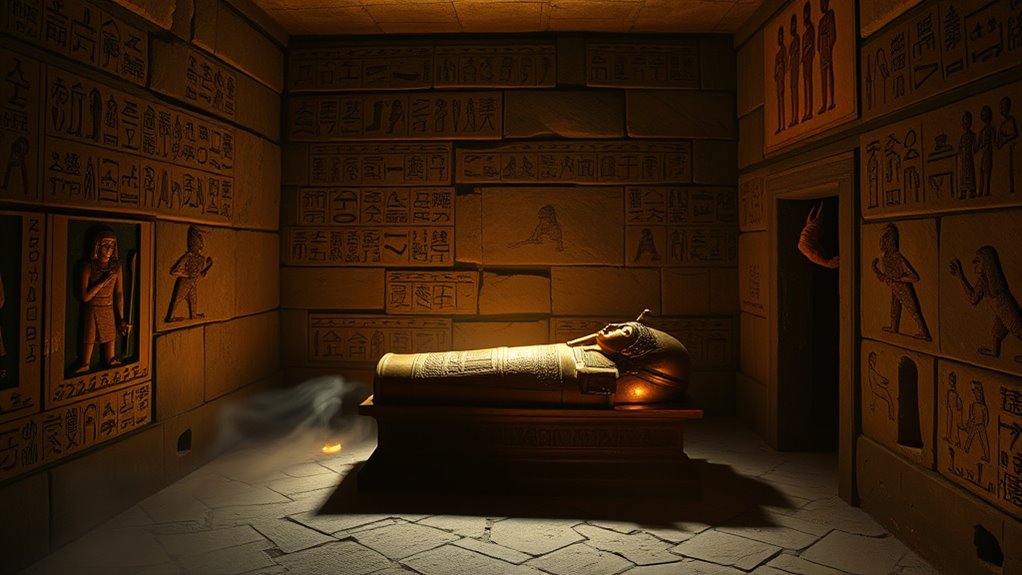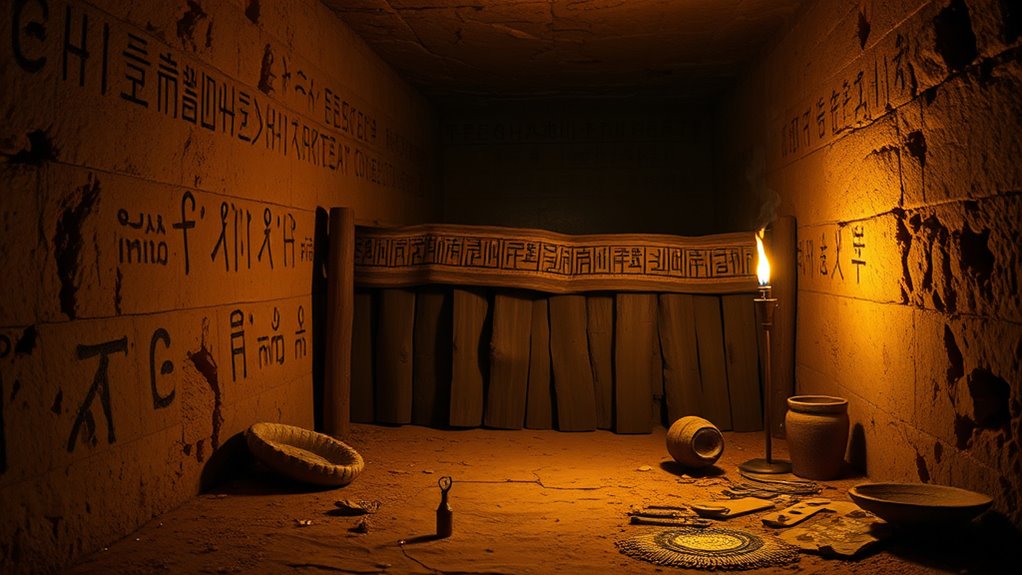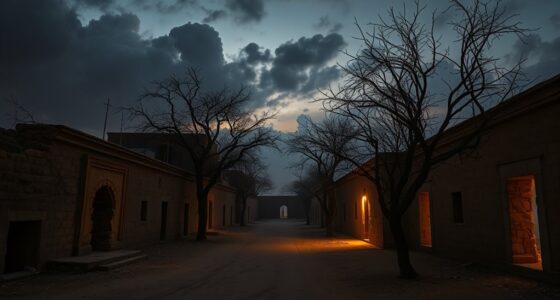When you explore the story of Tutankhamun’s tomb, you’ll find that its discovery in 1922 sparked a widespread belief in a supernatural curse. Media sensationalized any mishaps and linked them to a vengeful ancient spirit guarding the tomb. Fear grew around artifacts rumored to be cursed, amplifying superstitions about divine wrath. If you keep exploring, you’ll uncover how these legends continue to influence our view of ancient mysteries and archaeological discoveries.
Key Takeaways
- The curse belief originated from ancient Egyptian tomb protections and was amplified by media coverage of mysterious deaths, notably Lord Carnarvon’s.
- The tomb was discovered in 1922 by Howard Carter, revealing treasures that fueled superstition about a vengeful curse.
- Media sensationalized reports of mishaps and deaths, labeling artifacts as cursed and creating lasting supernatural fears.
- Superstitions influenced archaeological practices, emphasizing caution and respect for potential malevolent spirits within tombs.
- The enduring myth has inspired movies, books, and theories, blending archaeological achievement with superstition and mystery.

Few discoveries in archaeology have captured the world’s imagination like the unearthing of Tutankhamun’s tomb, but many believe that a deadly curse has haunted those involved. As you explore into the story, you’ll find that the mystery surrounding artifacts plays a significant role in fueling fears of supernatural retribution. When Howard Carter and his team opened the tomb in 1922, they uncovered treasures that had remained hidden for over three millennia. These artifacts, shimmering with gold and intricate craftsmanship, hold secrets that spark curiosity and awe. Yet, alongside their beauty, many believe they carry a deeper, ominous significance rooted in archaeological superstition.
The idea of a curse originates from the ancient Egyptian belief that tombs were protected by divine powers, and disturbing them could invoke wrath. When misfortune befell some members of Carter’s expedition—most famously Lord Carnarvon’s sudden death shortly after the tomb’s opening—the narrative of a curse gained traction. News outlets sensationalized these events, suggesting that the artifacts themselves were cursed objects, carrying a supernatural warning. This created an aura of mystery surrounding artifacts, where every unexplained death or mishap was seen as evidence of ancient curses. Interestingly, many of these superstitions were reinforced by archaeological superstitions that developed over time, influencing public perception.
You might think it’s just coincidence, but the archaeological superstition persisted, making many wary of touching or even studying these relics. Some believed that disturbing the resting place of a pharaoh could release malevolent spirits. As stories spread, even skeptics began to question whether there was more than just chance at play. The media played a vital role in amplifying the fear, turning what was initially a scientific discovery into a legend of supernatural punishment. Interestingly, the contrast ratio of images of the tomb often heightened the sense of mystery and drama in stories about curses. Additionally, the superstitions surrounding ancient artifacts have influenced how modern archaeologists approach their work, often leading to caution and respect for cultural beliefs. The cultural significance of these artifacts continues to shape perceptions of ancient Egypt and its mysteries.
The mystery surrounding artifacts wasn’t just about their age or craftsmanship; it became intertwined with fears that these objects embodied an ancient, vengeful power. This superstition seeped into popular culture, fueling movies, books, and theories about curses. You may wonder whether the curse was real or just a product of archaeological superstition and media sensationalism. Regardless, the idea persists that some artifacts are best left untouched, guarding their secrets to avoid releasing unseen forces.
Ultimately, the story of Tutankhamun’s tomb serves as a compelling blend of archaeological achievement and superstition. It reminds you how human fascination with the unknown can transform a scientific breakthrough into a legend that endures through generations—an enduring mystery wrapped in the allure of ancient curses.
Frequently Asked Questions
Did Anyone Truly Die Because of the Curse?
You wonder if anyone truly died because of superstitious beliefs surrounding ancient curses. While some claim deaths linked to archaeological ethics, evidence is scarce. Many believe the curse was more psychological than real, fueling fear and superstition. No definitive proof shows that the curse caused actual deaths, suggesting that these stories may stem from human imagination and the desire for sensational tales rather than factual events.
Were There Any Physical Artifacts Linked to the Curse’S Effects?
You might expect to find a cursed artifact, yet no physical object directly causes the ancient warnings to come true. Artifacts like the tomb’s treasures symbolize mystery and danger, but none have proven to transmit the curse’s effects. Ironically, it’s the symbolic power and narratives surrounding these artifacts that fuel fears, rather than any tangible link. The real danger lies in our minds, not in any cursed object itself.
How Did the Curse Influence Archaeological Practices Afterward?
The curse made you more cautious, blending ancient superstitions with modern archaeological ethics. You now prioritize careful excavation and respect for cultural sites, avoiding the reckless practices of the past. This fear of curses led to stricter protocols, ensuring that superstitions don’t override scientific methods. As a result, archaeology became more ethical, emphasizing preservation and respect for ancient beliefs, reducing risks of damaging artifacts or provoking bad luck.
Was the Curse Media Sensationalism or Based on Real Events?
You might think the curse was just media exaggeration fueled by superstitious beliefs, and that’s partly true. The media sensationalized the story, emphasizing supernatural elements to attract attention. While there’s no solid scientific proof linking the deaths to a curse, the fear and superstition definitely played a role in shaping public perception. So, it’s fair to say the curse was more media-driven hype than actual supernatural events.
Are There Modern Cases of Supposed Curse-Related Incidents?
You might wonder if modern superstitious beliefs still link incidents to curses. While many claim mysterious events around archaeological sites, skeptics argue these are often coincidences or media sensationalism. Archaeological ethics now emphasize scientific methods over superstition, discouraging fear-based narratives. Though some still believe in curses, most experts see them as cultural myths, and real accidents are usually due to negligence or natural hazards, not supernatural retribution.
Conclusion
As you step back from the mystery, remember that the curse of Tutankhamun’s tomb is like a shadow lurking in the sands of time. It whispers warnings to those who dare disturb the past, reminding us that some secrets are best left buried. Though history paints it as a tale of doom, it’s also a reminder of the power and mystery that ancient Egypt holds—an eternal darkness waiting to swallow the curious.









